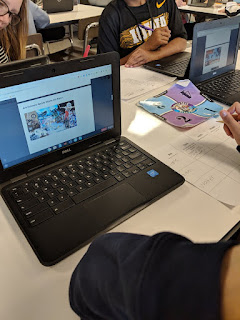We talked about some issues facing our world and the students chose an issue that hit home for them. Some the issues at hand are:
- Should we be more focused on protecting sharks from humans or protecting humans from sharks?
- Are Extreme sports worth the risk?
- Should we ban plastic bags?
- Should people be more focused on underwater exploration or outer space exploration?
- Should animals be kept in zoos?
- Is climbing Mount Everest worth the risk?


Once the students previewed the texts, we worked on a See-Think-Wonder activity to help get our thinking started! The students were given photos or videos relevant to their issue that they had to analyze. First they wrote down things that they could see, things that they could physically touch if they were to jump into the image or video. After that, they recorded some thoughts that were generated from the things they could see. They also justified their thoughts by writing what made them think that. For example, one student in the group researching extreme sports wrote this:
See: I see a man on a bike with his arms up.
Think: I think he has his arms up to help him balance.
Justify: I think this because when I struggle to balance while walking along the curb, I put my arms up and it helps.
Wonder: I wonder if BMX bikers have any other ways of balancing while performing tricks that require them to use their hands.

The "wonderings" led us to questions that really push our research further! We returned to our see-think-wonder papers to investigate our wonders and push our thinking deeper in our debatable issues. Here are some of the questions that kids were researching. These are questions that cannot simply be "googled," rather the students have to analyze the information presented in multiple texts and draw their own conclusions.

Now we are working on gathering evidence for both sides of the issue. The students are able to identify if a text is one-sided or gives both perspectives. We are setting aside our own opinions and researching both sides of the argument. We have even engaged in quick flash-debates to test out and clarify our thinking. It is incredible to see the different ways that kids decide to organize their thinking and cite their sources.


Our next step is to have a bigger and stronger debate after we expand our research to include background information in our argument. We will look for new information to make our arguments stronger! After this unit, I am confident that these kids will truly understand how to make informed decisions and will become active citizens in this world!










No comments:
Post a Comment